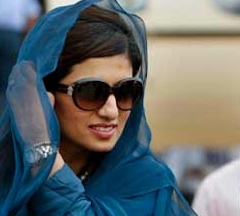Hina Rabbani Khar Helps Reveal Media’s Discriminatory Ways
Pakistan’s new foreign minister, 34-year-old Hina Rabbani Khar, arrived in India on Tuesday amidst a media frenzy. This was no surprise. Pakistan-India talks are a matter of national import in both countries, and round-the-clock updates on the minutiae of such meetings are de rigueur.
But few Indo-Pak diplomats have garnered the kind of press Khar has. The website of Indian television network IBN currently features a photo-gallery of Khar looking “gorgeous.” Style blog High Heel Confidential praises her “simple” outfit, but pokes fun at her “crushed kurta.” The piece-de-resistance: a four-minute analysis of everything from the estimated value of Khar’s handbag to how she drapes her dupatta on Indian channel News 24 (see video below).
Kashmir and the like didn’t really feature amidst such highfalutin commentary.
It would be easy to turn this into a joke about an amateurish Khar: her inexperience, her youth, and her degree in hotel management. And yes, maybe she could do without that Birkin.
But what her reception really represents is the fact that she’s hit the glass ceiling the way women all over the world do.
Whether they’re foreign ministers like Khar, writers like Fatima Bhutto or high-ranking political aides like Hillary Clinton’s “body woman” Huma Abedin, professional women who are young and in the spotlight are often judged on the basis of one standard: femininity. Their “beauty” and “style” are played up in article after article, becoming a critical part of their success. It’s not their professional achievements, then, that matter. It’s whether they conform to expectations about what a young woman should be like. If they do, and they can handle a career on the side, huzzah!
The most patently ridiculous part of such gender-based expectations is how divorced they are from real-life success. Hillary Clinton managed to be a key political player during her husband’s time in office, a highly notable senator, the first female presidential candidate in US history and work her way into a prime post in Obama’s administration with a wardrobe that consists primarily of putrid pantsuits. Noted activist Tahira Abdullah, a key part of the Pakistani feminist movement, is rarely, if ever, seen in an outfit more elaborate than a simple, printed shalwar kameez. Both have made inimitable marks on their nations’ histories.
But then again, they never made it to Vogue or the fashion blogs. They never made for good photo-galleries. They had to become relevant using determination, guts and every talent they possessed. A double standard is clear: if you conform, that’s what will be played up. If you don’t, fight to the top and then we’ll cover you (funnily enough, Hillary Clinton is now occasionally deemed “elegant”).
It is perhaps ironic that it’s the media’s treatment of Khar in particular that has highlighted its discriminatory ways. After all, many argue that Khar was chosen for the express purpose of projecting a softer image of Pakistan, and (in News 24’s words) “charm[ing]” foreign officials into maybe mistrusting Pakistan a tiny bit less.
But Khar must have a chance to succeed before we dismiss her. She exists within an unfair system rife with gender discrimination many choose to ignore, claiming “all that feminist work has been done.” It’s time to change the standard. Let Khar and her peers be fashion plates, by all means. Kate Middleton could use the competition. But first consider them as what they truly are: professional women.
Click play to watch the video of News 24’s report on the style of Hina Rabbani Khar.
[youtube]http://www.youtube.com/watch?v=yxchKWJ9ViU[/youtube]
Related article:
Indo-Pak Relations: IEDs, Stones and Dialogue
Akbar Shahid Ahmed is a Washington-based reporter for the Huffington Post, writing on U.S. foreign policy. He has contributed to Newsline since 2008.




